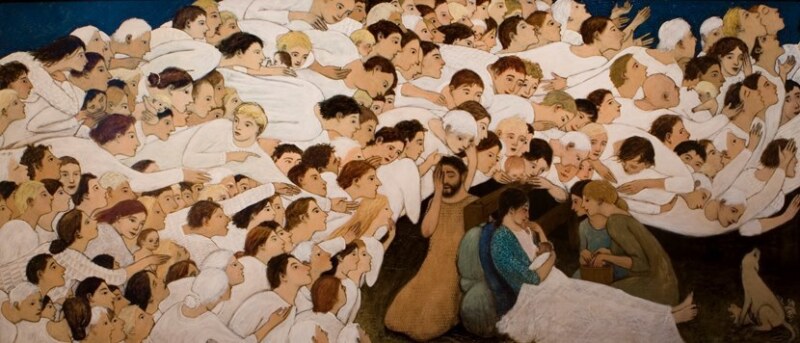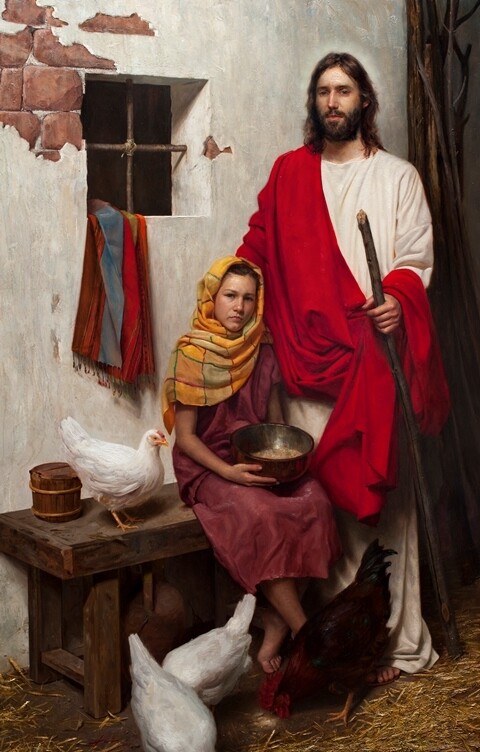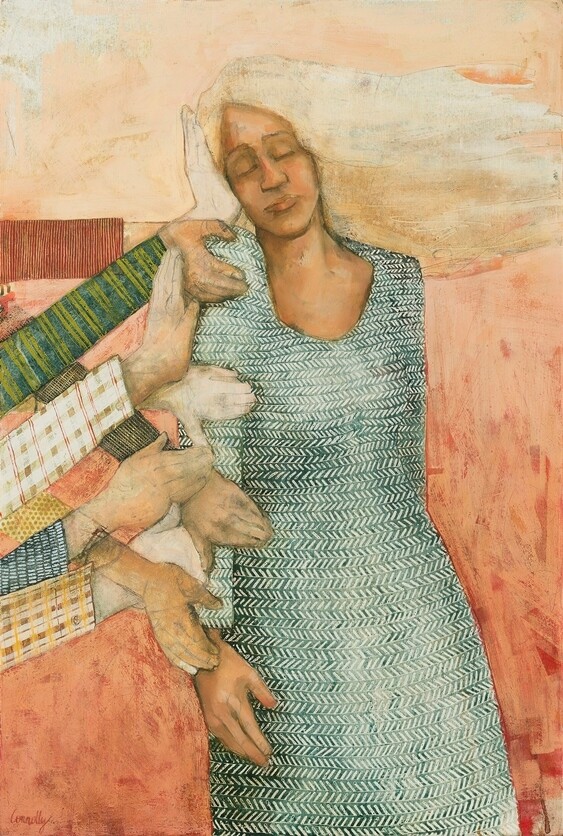Ruth
SANDRA RAST
It took close to a year of on-and-off work for LDS painter Sandra Rast to complete Ruth, but the end result was worth the wait.
About the stunning painting, Rast says, “I put the beauty and softness in her eyes to represent the beauty of her inner attributes, that she’s good and gracious with dignity and charity on the inside. You have to paint the outside to show she internally had those characteristics we all seek.”
Other symbols found in the painting include the light around Ruth’s head, which represents revelation, knowledge, and truth. The heavy use of gold in the background and the color of the wheat symbolize things that are pure and precious, as well as the celestial kingdom, our ultimate goal. Ruth’s hands are a focal point of the piece, showing her strength and representing providence and blessings, especially those that come through work.
“People tell me I’m an ‘emotional painter,’” Rast confesses. “I love it. I want to be the emotional painter. I want my paintings to bring out the emotions within us that will teach us.” She explains, “If we look underneath the stories, we realize there are feelings and emotions that can influence our own lives.”
Purchase Ruth for your home at Deseret Book stores and deseretbook.com.
Eternal Companions
MIKE CALL
Originally created as a gift for the parents of the sculptor’s assistant, Eternal Companions was made to show the special relationship senior missionaries have with each other and with the Lord.
Mike Call, the artist behind the work, explains: “I wanted to capture a couple walking side by side, hands clasped affectionately, leaning on and supporting each other. I envisioned them anxiously engaged in missionary service, possibly heading off to a teaching appointment. I wanted to capture the joy both of service and of the special relationship between a committed husband and wife—eternal companions.”
As Call worked to carefully craft Eternal Companions, he says, “I thought about my parents, who are serving a part-time mission, and my grandparents, and great-grandparents, many of whom served as couple missionaries. I began to think about what was different from my mission as a 19-year-old and their missions. It became clear that this was a special service that they could render together with the companion of their choice, the person that they shared sacred covenants with and had spent the majority of their lives with, raising a family and serving faithfully in the Church. It became clear to me that what was really at the heart of this sculpture was that special relationship, the dedication to each other and to the Lord.”
Purchase Eternal Companions for your home at Deseret Book stores and deseretbook.com.
Adorned with Forget-Me-Nots
ROSE DATOC DALL
The Young Women value of individual worth is stunningly displayed in Rose Datoc Dall’s painting Adorned with Forget-Me-Nots, a piece which Dall hopes sends the message that each one of us, particularly women, is of infinite worth.
“I think each young woman needs to be able to know that she is loved and valued,” Dall says. She adds that this goes for adult women as well. She hopes that every woman who sees her painting may understand that the Lord loves her individually and will never forget her.
Bekah Pence, the model depicted in this painting, is surrounded by the color red, which represents courage and that a virtuous woman’s value is far above the price of rubies. Her hair is lined with forget-me-not flowers, a nod to President Uchtdorf’s October 2011 address, “Forget Me Not.”
Dall hopes each woman can know of Heavenly Father’s love for her through this painting. “You just need to rely on the Savior and remember that the Lord loves you,” she says. “In all of our crazy, busy lives, the only one needful thing is having a good relationship with the Savior.”
Purchase Adorned with Forget-Me-Nots for your home at Deseret Book stores and deseretbook.com.
Follow Me
LIZ LEMON SWINDLE
LDS painter Liz Lemon Swindle has become a beloved household name among Mormons, and her inspiring LDS artwork hangs in homes around the world. Her newest painting, Follow Me, captures the meaning behind Christ’s call for us to follow Him.
Inspired by Christ’s words to “come unto me, all ye that labour and are heavy laden, and I will give you rest,” Swindle took on the task of painting the essence of faith: to follow Christ without actually seeing Him.
“So few of us will ever get to see the Savior’s face in life, so I chose to paint only His feet,” says Swindle, reminding us of the need for faith to believe in what we cannot see. You don’t have to see Him to know Him.”
According to Swindle, the biggest challenge of this piece was getting the water just right. “Water can be tedious, even in the most inspiring paintings. I learned early on that there really aren’t any shortcuts. Just like in life, there are things we must hunker down and do. When the Savior asks us to follow Him, He doesn’t promise us a smooth path; to do so would deny us the opportunities we must have if we are going to learn faith.”
Purchase Follow Me for your home at Deseret Book stores and deseretbook.com.
Lead, Kindly Light
SIMON DEWEY
“An invitation to salvation” is how artist Simon Dewey describes his newest sculpture, Lead, Kindly Light. While he loves his painting of the same name, which inspired his new sculpture, he explains that there is only so much an artist can control in two dimensions: “The canvas can only contain so much. With three dimensions, one is unconsciously encouraged to move around the art and allow the gaze to rest on any angle from any vantage point.” So he commissioned a third party, under his careful direction, to translate his painting into a beautiful bronze statue.
Dewey loves the metaphor of light—its beauty and meaning to those of us struggling through life. His sculpture captures the Savior lighting the way with one hand and beckoning to us to come to Him with the other.
As Dewey continues to create images of the Savior, he wants observers to find something beyond the medium. “Religious art has the illustrious tradition of being able to inspire, console, motivate, and educate,” he explains. He loves that some people describe his artwork as a “visual utterance to our testimonies,” but he humbly recognizes his talent as a gift, a way to share his own feelings about the gospel.
Purchase Lead, Kindly Light for your home at Deseret Book stores and deseretbook.com.
Mother’s Lullaby
ANNIE HENRIE
Angels are often a part of Annie Henrie’s paintings, and Mother’s Lullaby is no different. The painting portrays a baby being watched over by a loving mother, who is also being watched over.
Henrie says angels like these are representations of love. They remind her of the people in her own life—her mother, friends, and family—who have been angels to her.
However, angels aren’t the only symbolism found in this beautiful painting. An observer might notice some slim yellow halos around the heads of the angels, influenced by Renaissance art. Henrie explains that the halos were a way of setting a painting apart as holy and the people with halos as holy people. But Henrie goes on, “They’re kind of incomplete, especially with the mom. Her halo isn’t really complete, but it’s there. She’s not perfect yet, but she’s still a divine person. She’s getting there.”
The title, Mother’s Lullaby, brings the entire piece together with a special corresponding motif within the painting: “If you look at it closely, it has sheets of music woven throughout the painting. I think a mom singing a lullaby is the perfect moment of feeling watched over. Feeling the closeness and tenderness and love, I feel like the word lullaby invokes all of those.
Purchase Mother's Lullaby for your home at Deseret Book stores and deseretbook.com.
Nativity
GREG OLSEN
Greg Olsen has depicted the figure of Jesus Christ in countless paintings, but there was always one piece that was missing from his portfolio: a nativity. But thanks to a tight deadline and a lot of inspiration, Olsen finally checked this item off his artistic bucket list.
He wanted his piece to have that magical effect that accompanies Christmas, so he set out to capture it with vivid colors. “Christmas is very much about color!” he says. “The sparkle of ornaments and tinsel, the flare of colorful packages and bows. This painting gives a nod to the theatrical Christmas spirit, especially in the costumes of the wise men. I made an effort to use light and color as devices to help your eye travel through the painting, while always returning to the focal point of the Christ child.”
Instead of trying to put a new twist on his nativity, Olsen tried to enhance the traditional scene of the nativity. “I wanted the image to feel familiar,” he says.
And no word could more aptly describe this scene than that: familiar. The intimate yet ornate portrait brings viewers right into the stable, giving them a glimpse of what it may have been like to see the Son of God come into this world. Olsen’s Nativity can be found in a new book titled Stars Were Gleaming, available now at Deseret Book stores and deseretbook.com.
Purchase Nativity for your home at Deseret Book stores and deseretbook.com.
Day One
COURTNEY VANDER VEUR
The idea for Courtney Vander Veur’s Day One came while she was experimenting painting with a combination of oil paint and turpentine. As she dripped water on the mixture, she noticed it would move around on the canvas and leave lots of circles and paths. “I started to feel like the paintings felt slightly cosmic, like planets or cells dividing,” Vander Veur explains. Seeing some paintings of the creation in the Church museum a short while later confirmed what she wanted to do with her experiment.
The process of creation is important in every aspect of Vander Veur’s painting. Day One took weeks to complete as she waited for layers of color, starting with yellow, to dry before adding others, creating darker parts on the canvas simply by adding more layers. “The thing that I love about it is that it was actually a spiritual experience creating it, because I felt like it kind of created itself as well,” Vander Veur recalls. Often when she would try to control where the paint went, it wouldn’t stay. “So I ended up getting a lot of marks on the painting that I think are really beautiful that I couldn’t have done if I wanted to.”
The amazing spiritual connection Vander Veur found while creating Day One convinced her to include it in her application for the 2014 Deseret Book art scholarship, where it was one of the four scholarship winners.
Purchase Day One for your home at Deseret Book stores and deseretbook.com.

Mother and Child (series)
J. KIRK RICHARDS
While the Mother and Child painting series represents only a small fraction of J. Kirk Richards’s work, it’s a fraction he says is one of his favorites. “I love mother and child images. A mother’s relationship with her baby is a sacred one that echoes the sacred relationship between Mary and the baby Jesus. Those relationships are the height of beauty—the kind of beauty I want to capture in my paintings.”
In particular, Richards says his paintings are “stylized mother and child images. They are a fusion of the old and the new—the traditional Madonna and child, but translated by an artist of the 21st century.” But the subject of the series isn’t necessarily the nativity. “The mother and child could be Mary and Jesus, or it could represent any mother and child. It could be my sister and her newborn. It could be my mother and me. It could be my wife and our children.”
Each painting in the series also includes similar imagery and symbolism. “The halos represent holiness,” Richards explains. “The clothing is changed into abstract shapes and designs. I don’t want the paintings to refer to a specific time or place. Even though the painting may represent Mary and Jesus, the painting itself is a symbol and not an historical depiction. The idea or the essence is more important.”
Purchase Mother and Child paintings for your home at Deseret Book stores.

Nativity
BRIAN KERSHISNIK
Although Brian Kershisnik’s enormous piece Nativity might have a typical name, it’s anything from your traditional nativity scene. This oil painting spans the width of Kershisnik’s entire studio at 17 feet wide and 7 feet tall. The enormity of the project was rather daunting for him. “I had never tried a sacred subject on a monumental scale,” he says, “and it shook me pretty good.”
Kershisnik knew he wanted to take a different spin on the typical nativity scene. Instead of focusing on Mary, Joseph, and the Christ child, he overpowers the scene with crowding angels, waiting to get a glimpse of the miraculous birth.
“I was interested in a subject involving a lot of angels,” he says. “I believe that the births of my own children were very witnessed and populated events, and I decided to try a painting of Jesus’s birth surrounded by a host of angels.”
A concourse of angels isn’t the only unique aspect to this painting. Kershisnik also incorporated two young midwives into the piece to show how women could have helped with the birth. “Nothing seemed more obvious to me in the world than the fact that women would come and help in such a circumstance.”
Through his painting, Kershisnik hopes to convey the humanity of Christ’s birth: “His birth was like yours and mine. He came here into our sweat and blood and milk and mud. Whatever the recorded details of the event may be, He came. And everything depended upon it.”
Purchase Nativity for your home at Deseret Book stores.

As a Hen Gathereth
JEFF HEIN
Depicting a young girl tucked against Jesus Christ in an unknown town near Jerusalem, Jeff Hein’s paintingAs a Hen Gathereth serves as an empowering reminder of both the Savior’s love for each of us and our own ability to become like Him.
“He might have been walking down a street in Bethlehem or Nazareth or Jerusalem and just come across this average girl in an average town and befriended her,” Hein says.
The painting creates a hierarchical and symbolic ladder from right to left, starting withthe Savior and moving downward. The young girl holds a bowl of chicken feed, which is the central symbol of the piece, Hein says. “She is caring for the chickens. Without her, the chickens would be lost. They probably would not even survive.”
Her concern for the hens is just like Christ’s concern for each of us, and in caring for them, she both represents the Savior and shows her love for Him. Ultimately, every living thing in Hein’s painting, including the chickens, symbolizes Jesus Christ.
See this artwork as an original painting exclusively in the temple.

How Did I Get Here?
CAITLIN CONNOLLY
Vibrant and whimsical, painter Caitlin Connolly’s piece How Did I Get Here? tells the story of how our lives are often guided by the people around us.
The woman in this painting is held up by the hands of those Connolly considers friends, family members, or even angels that are put into our lives to strengthen us.She says that her painting, which is both a self-portrait and a general portrayal of the situations we find ourselves in, captures those moments of introspection when we sit back and think about where we are.
“You’re not sure exactly how you got there except for the help of other people,” Connolly says. “I think, in a lot of ways, we’re not really in control, and so I think it’s a narrative about that.”
The painting, she adds, is not so much about departure or arrival as it is about progression and being constantly moved forward by the people in our lives.
Only available as an original painting by the artist.








